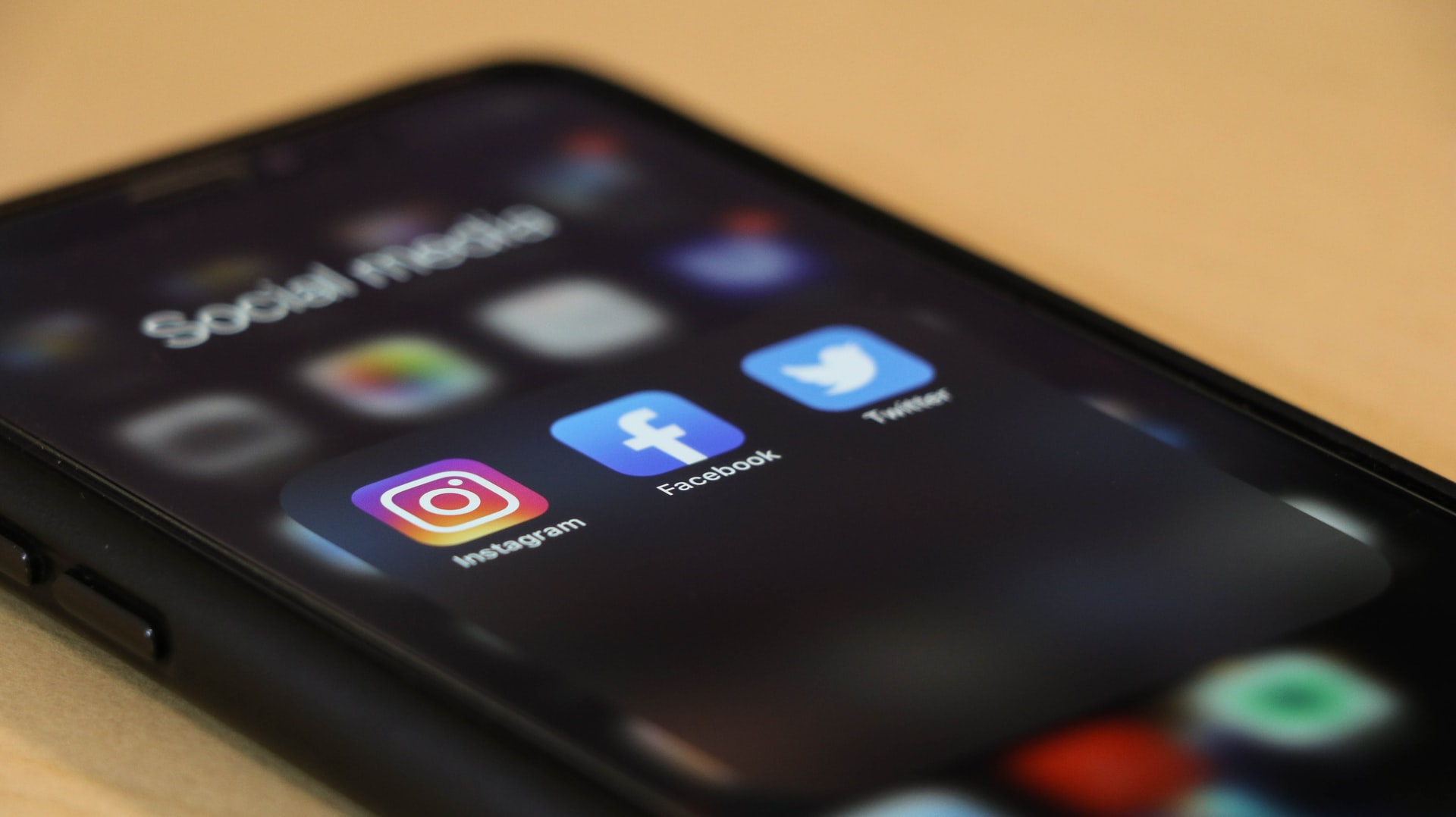Abstract
In this new digital age, everyone is getting new social media accounts left and right. Whether or not you think social media is the devil or the best thing to ever happen to humanity, it’s going to have some effects on both children and adults. In this paper I will be discussing how teens and adults, including myself use certain social media, why we post what we post on each site, and why it’s beneficial to our identities to do so across several accounts. I plan to go over the different types of social media, the demographics of each site, the purposes and audience of each site, among other factors that could play into how each social media site is different and useful for shaping people’s identities. In my research I find that social media has a key role in helping us share our identities in ways that we couldn’t before.
Keywords: social media, social networking, identity, internet, accounts
________________________________________________________________________________________
Who am I and what is this paper about?
Hello, I am a college student, and at the time of writing this autoethnography, am 19 years old. In this paper I want to explain to everyone why it’s beneficial to have multiple social media accounts across multiple sites. Not only have I included multiple sources of why using multiple accounts is beneficial to our identities and to us as a whole, I include my own experiences growing up in this digital age, while more and more kids and adults have been getting on social media and are creating new accounts all the time.
Who uses which social media site the most?
Pew Research Center (2022), a well-known organization who posts research regarding several different topics released a fact sheet (See Figure 1) regarding the adults of America and their social media use. Unsurprisingly YouTube and Facebook remain the highest used considering how YouTube tends to dominate their area of social media and Facebook has been around for almost two decades and tends to advertise as a family friendly site, however the research doesn’t cover who is creating content on YouTube versus just watching which is important when considering that a large number of YouTube’s user base doesn’t actually produce any content themselves. If you look at the Facebook category on figure 1, you can see that it is the most used across every category. Facebook is well known amongst teens and young people to be a site for “old people” as many put it, however regardless, a lot of people still make an account and use it to keep up with older relatives.
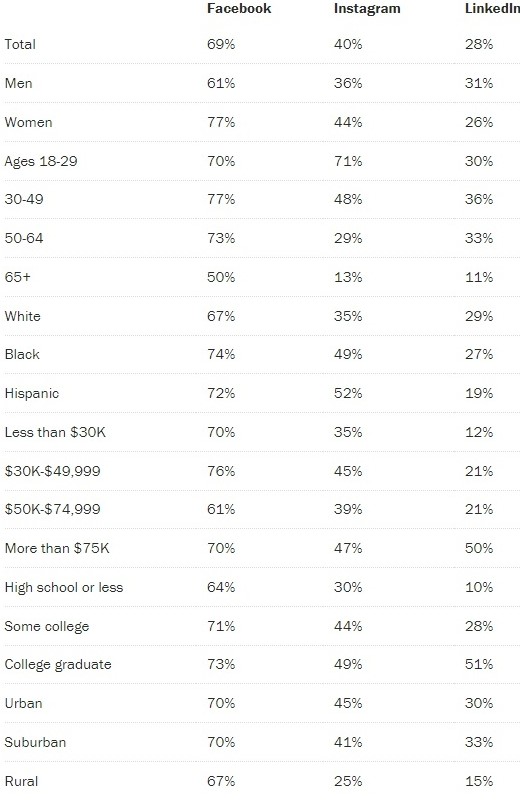
| Figure 1: Which demographics use which sites (Pew Research, 2022) |
As you can also see in figure 1, Instagram is very popular with adults aged 18-29. Instagram has a reputation for being where many friend groups gather to talk and share photos whether they’re real life pictures or funny internet memes and trends. Other sites not listed also have different reputations, such as Twitter for being where you go to talk about celebrities or your passions, and then TikTok which is where many people both go to get information and for funny videos. I personally am not a part of these statistics, and I can’t speak about most of the demographics, however from my experience, most of the people I know, and including myself, who are a part of the 18-29 age range do have both Instagram and Facebook. Not on the chart is other social medias like YouTube, Twitter, and TikTok. However, Pew Research (2022) did release those statistics too. YouTube is generally higher than Facebook with roughly 80% or more in almost every category with age range 65+ being a noticeable outlier of 49%. Twitter and TikTok are both around the 20% marks when it comes to the total amount of people that they gathered results from that use those sites. I do want to point out that these statistics don’t include anyone under the age of 18, I feel like when it comes to social media it’s important to consider that social media that’s popular with younger adults in the age range of 18-29, minors around ages 13-17 would likely follow similar statistics.
New users and accounts all the time
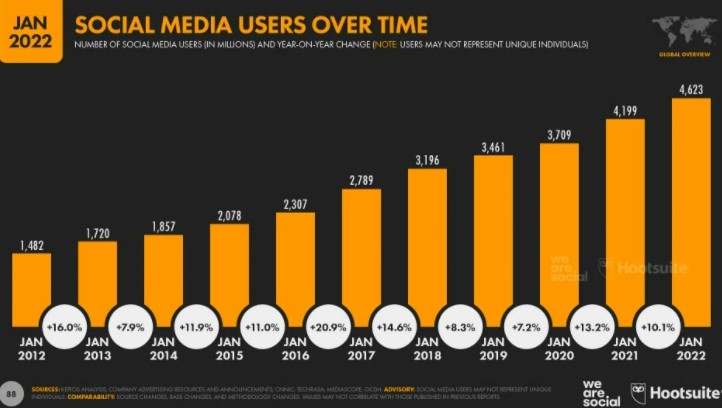
| Figure 2: Social Media Users/Accounts, 2012-2022 measured in millions (Kemp, 2022) |
Social media continually grows its users all the time. As more and more teens are allowed to make accounts on various sites, it’s no surprise that as long as a social media platform doesn’t go bankrupt or discontinue their services, it will amass millions of users. I started using YouTube when I was a kid probably around the age of eight or nine along with creating a Facebook account so I could talk to my family members, and it wasn’t until around thirteen that I got on Instagram. Ever since then I’ve made multiple social media accounts across multiple sites when I felt like I needed to. My little sister has already started on the same trend, using YouTube constantly and she has recently gotten a Facebook too. Multiply those random new accounts in someone’s life across the billions of people in the world and every day social media platforms grow. I do want to note that in figure 2 that they don’t differentiate users from accounts, so for example every time I made a new Instagram account, this chart would have reported me as a new user despite previously using the site.
Why do people use each site?
Each site has a different purpose. They all have a specific type of goal in mind. You have dating apps like Tinder and OkCupid that are trying to help you find “the one.” Then you have sites that are meant to be used for social networking like Facebook and Twitter. Similarly, you have LinkedIn for your more professional networking. Sites like Tumblr and Medium are used for blogging, though Tumblr does have a big image sharing aspect which is similar to Instagram and Pinterest which are more for media sharing. That being said everyone uses those sites differently whether or not it’s for the site’s intended purpose. A lot of people for example use dating apps to find friends, a lot of people take to Twitter to discuss celebrities, and small businesses will create accounts on Instagram and TikTok to promote their shops. I use mainly Instagram, I use it to chat with my friends, share funny images I find, and use it to share my different interests while I will use Twitter to stay up to date on news and developments in my favorite shows and my Facebook account is specifically for family connection.
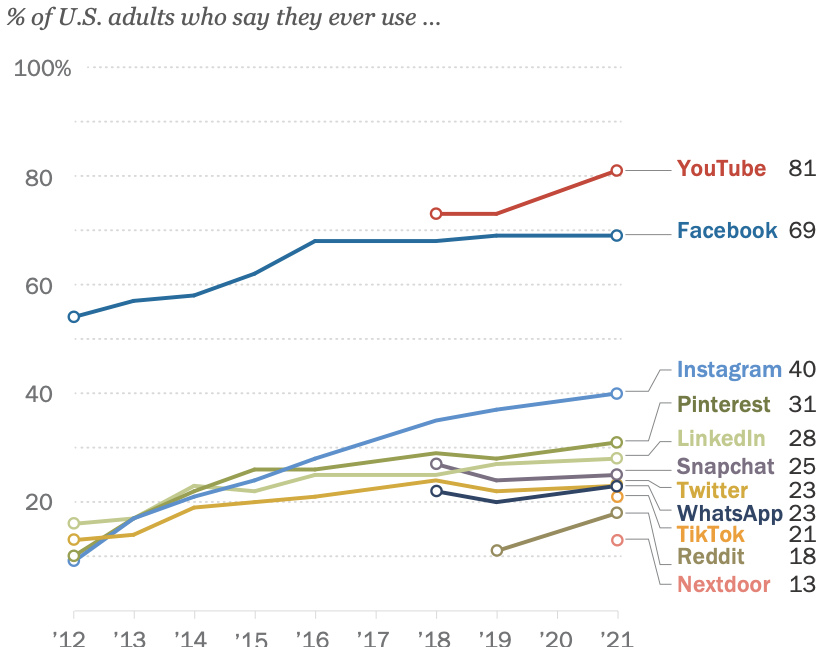
| Figure 3: A graph showing how the % of U.S. adults who use sites has changed from 2012-2021 (Auxier & Anderson, 2022) |
Figure 3 includes which sites adults tend to use, using this knowledge we can assume a lot of adults are more interested in using social media for entertainment or for family and friend networking which given the state of the world, it’s not surprising in the slightest, though I will say the stability in Facebook since 2016 is interesting since it’s one of the most popular sites and with the pandemic, those who didn’t have an account would likely have made one. Another note about the graph is that it’s people who simply use the site, rather than sharing content for others to see. The percentage of YouTube content creators is likely much lower than figure 3 shows.
How does this all tie into identity?
Our identities are unique, no two humans are going to have the exact same interests, life, and goals. That’s why there’s so many different social media sites. The main goal of social media and the main reason it exists in the first place is to allow a person to share their identity and to connect with those around them. However, maybe you’re like me and may not want to share all aspects of your identity on one site. Perhaps on Facebook you have all your family on your friends list, so you don’t want to share your sexual orientation or gender identity, that’s personally why I choose not to share it there at least. However, on Instagram, you can stay as anonymous as you want so you can share those aspects of your identity, I even went as far as to make an account promoting and educating people on different orientations and identities because nobody knew who I was, so I didn’t have to worry about backlash in person. Each site can be tailored to the parts of your identity that you want to share through both privacy settings and your personal choice on what to post, and while some sites are better than others for sharing certain aspects of your identity, the main goal of most social media sites is that you can share practically whatever you want. Nowadays, a lot of people use social media specifically to discuss politics and raise awareness about different causes and movements such as the Black Lives Matter Movement, and issues surrounding corrupt companies who mistreat employees and other issues. To a lot of people, showing those aspects of their identity, what they believe in, and what they support, has become very important. I know among my social circles and those in my generation, called gen z, we have taken to social media to share out political identities and fight for various causes. Figure 4 does state otherwise, but the article mentions specifically adults, and it doesn’t address minors which make up a large part of the social media political world (2021). I felt like the graph was still relevant because it brings up not only the possible generational difference, but the importance of being able to conceal your identity on social media as a large percentage of the respondents don’t post out of fear of backlash. In the future, there may be other parts of people’s identity that become more mainstream and more relevant for people to share online rather than in person.
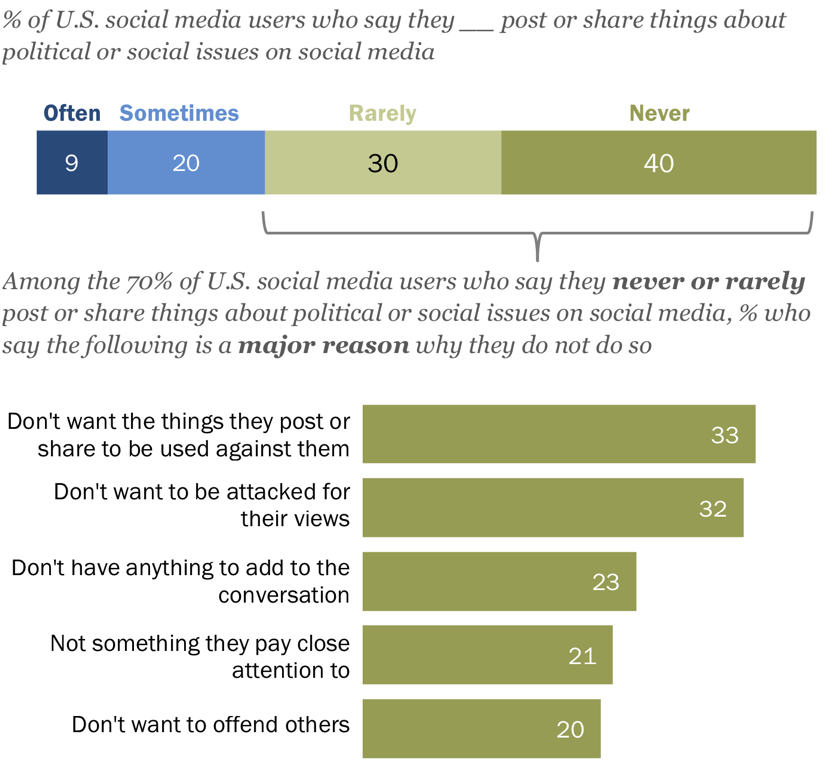
| Figure 4: A graph showing how the % of U.S. social media users who post political or social issues on their accounts along with their reasons (McClain, 2021) |
Why is it beneficial to have multiple accounts?
Well for starters, I use my different social media accounts to share different parts of my identity to those who care about that part. For example, I have an account dedicated to my real life, where people like my friends and family follow me. However, I also have multiple accounts dedicated to different hobbies of mine like my art account and at one point my photography account. Those who don’t care about those parts of my identity may be more interested in my Animal Crossing account where I share my love for that franchise. That being said, having multiple accounts allows me to reach people who care about what I have to post without making them see things they don’t care about. Specifically, being able to aim for an audience by having multiple accounts lets people control the social context as well, danah boyd, a well-known author who covers social media and how it affects teens covers that extensively (2014). She also brings up the idea of it pretty much creating separate digital personas because it’s like you’re in two places at once (2014).
A far bigger reason to have multiple accounts comes from a paper by Nomy Bitman (2022). This study focused on users who have different communicative disabilities such as Autism or a stutter among other things. The autistic women in the study said they preferred to have multiple accounts because they felt that neurotypicals; those without those sorts of disorders; had trouble handling them and were “too much” as they put it, so they used multiple accounts to spread out their identity and make it easier for others to handle (2022). Another study by Salaudeen & Raji (2018) looked at teens from Nigeria and how they expressed themselves digitally and I feel that they described a good reason for people to even have social media by saying “social media sites provide growing and searching teens a space to negotiate, explore, reconfigure, and, in the process, test the effects of their presented self-image on others, while clarifying to themselves who they are” which to me really solidifies the idea that multiple accounts are great as they allow teens to do that more specifically and see which they like better (p.92). I know as I was growing up, I used multiple accounts to explore who I was because I got to split up parts of myself into easier pieces to explore. Trying to explore my hobbies, interests and personal identity in the form of things like gender and sexual orientation would have been difficult if I was talking about them all on one account and less people interacting with it due to the overwhelming variety of topics present.
How does being able to express our identity help us?
Self-expression has always been essential to happiness, whether we express ourselves through art, blogging, or any other creative venture. Social media can help us both share those creative ventures or be a creative venture as many teens and young adults will try to make their Instagram, or Pinterest, or any account they have look aesthetically pleasing to a viewer’s eye. Sharing our identities can feel very freeing to some people, it also helps when it comes to social networking and becoming better friends with those who follow us. Self-expression not only helps our social lives, but also helps us feel better about ourselves and helps our mental health. Dona Matthews Ph.D (2019) is a developmental psychologist who wrote an article about creative self-expression in children, she also talks about how “Creative self-expression reduces stress and increases a sense of well-being and other positive emotions,” (Paragraph 7). And as discussed earlier, social media can be creative, but also just in general self-expression has been linked to similar effects in both kids and adults alike. In my experience, using social media to express my identity has only improved my life. It allowed me to make a lot of new friends, especially those with the same interests as me. It also helped me figure out myself in terms of both gender and sexual orientation because I was surrounded by members of the LGBT community due to me sharing that part of my identity and learning more about that community through both the online members and social media in general.
The Takeaways
Social media has grown, and more and more adults are starting to use it as well. We have so many different sites because each site is better for a certain reason, whether the site is popular because it allows easy networking, or because it allows for more media sharing, they’re all important in the grand scheme of things. We also want all these different sites to allow for better self-expression and to connect with different age groups as some sites are more popular than others for older audiences. Overall, social media is a great way to share our identities and having multiple accounts is just a way for social media to help us break down those identities into bite sized pieces for people who we want to share them with. Social media has helped me grow in ways that I don’t think would have been possible without access to people from so many communities and access to all sorts of media that helped me both discover my identity but also helped me figure out what I wanted to share with the world.
References
Aremu Salaudeen, K., & Ayobola Raji, N. (2018). Digital Devices and Self-Expression among Teenagers in Osogbo, South-Western Nigeria. Language & Semiotic Studies, 4(3), 84–100.
Auxier, B., & Anderson, M. (2022, January 31). Social media use in 2021. Pew Research Center: Internet, Science & Tech. Retrieved February 28, 2022, from https://www.pewresearch.org/internet/2021/04/07/social-media-use-in-2021/
Bitman, N. (2022). “authentic” digital inclusion? DIS/ability performances on social media by users with concealable communicative disabilities. New Media & Society, 24(2), 401–419. https://doi.org/10.1177/14614448211063183
boyd, danah. (2014). It’s complicated: The Social Lives of Networked Teens. Yale University Press.
Kemp, S. (2022, January 29). Tiktok gains 8 new users every second (and other mind-blowing stats). Social Media Marketing & Management Dashboard. Retrieved February 28, 2022, from https://blog.hootsuite.com/simon-kemp-social-media/
Matthews, D. (2019, September 25). Creative self-expression for health, coping, and resilience. Psychology Today. Retrieved March 1, 2022, from https://www.psychologytoday.com/us/blog/going-beyond-intelligence/201909/creative-self-expression-health-coping-and-resilience
McClain, C. (2021, May 4). 70% of U.S. social media users never or rarely post or share about political, social issues. Pew Research Center. Retrieved February 28, 2022, from https://www.pewresearch.org/fact-tank/2021/05/04/70-of-u-s-social-media-users-never-or-rarely-post-or-share-about-political-social-issues/
Pew Research Center. (2022, January 11). Demographics of social media users and adoption in the United States. Pew Research Center: Internet, Science & Tech. Retrieved February 28, 2022, from https://www.pewresearch.org/internet/fact-sheet/social-media/
Storm, M. (2020, April 1). 5 types of social media for growing your business strategy. WebFX. Retrieved February 28, 2022, from https://www.webfx.com/blog/social-media/types-of-social-media/
van Dijck, J. (2013). ‘You have one identity’: Performing the self on Facebook and linkedin. Media, Culture & Society, 35(2), 199–215. https://doi.org/10.1177/0163443712468605
